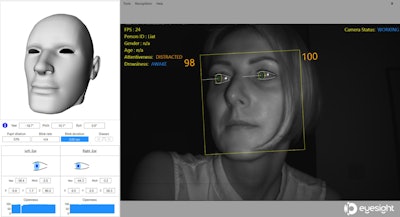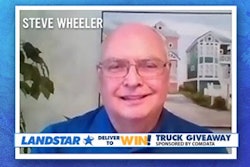Fleets that use forward-facing cameras to record critical event footage are not seeing much resistance from drivers. Inward-facing cameras, on the other hand, continue to raise privacy concerns despite the potential to mitigate two of the most risky driver behaviors: distraction and fatigue.
 Eyesight Technologies uses facial recognition software to identify distraction and drowsy driving, among other risky behaviors.
Eyesight Technologies uses facial recognition software to identify distraction and drowsy driving, among other risky behaviors.Driver distraction caused 2,841 fatalities and 400,000 injuries on U.S. roads in 2018, according to the most recent statistics from the National Highway Traffic Safety Administration. Drowsy driving is the leading cause in 21% of fatal crashes, according to a 2014 study by AAA.
With new advancements in camera vision technology, resistance to driver-facing cameras may be coming to an end.
Setting a new standard
Advanced driver assist systems (ADAS) such as collision mitigation, anti-rollover and lane keeping systems already are required on new passenger vehicles. Motor carriers are spec’ing them voluntarily on new tractor purchases at an estimated 50% rate.
Some countries soon will require new vehicles to have inward-facing cameras to further improve road safety. Last December, the European Union updated its general safety regulations. Starting in 2022, vehicles must have driver sensing cameras to obtain the full safety rating. By 2024, any new vehicle that does not have a drowsy driver monitoring system cannot be registered.
China has taken a more aggressive approach. It has required that all commercial vehicles built in 2019 and 2020 have driver monitoring systems (DMS) to detect seatbelt usage, drowsy driving and distracted driving events such as smoking and phone usage.
 Driver monitoring systems will become standard in vehicles to improve road safety and the driving experience, predicts Tal Krzypow, vice president of product for Eyesight Technologies.
Driver monitoring systems will become standard in vehicles to improve road safety and the driving experience, predicts Tal Krzypow, vice president of product for Eyesight Technologies.Vehicle OEMs are working with camera vision technologies to integrate DMS and ADAS systems. If a DMS detects a distracted driver at the same time an ADAS system detects a vehicle ahead, the adaptive cruise function could kick in automatically to improve safety.
DMS also could verify that a driver’s eyes are tracking a pedestrian that is detected by an ADAS system. If the driver is not paying attention, the vehicle’s braking or steering systems could activate to avoid an incident.
The extra sense
Computer vision company Eyesight Technologies is working on DMS projects with vehicle OEMs in the United States, China and Europe, said Tal Krzypow, vice president of product for the Israel-based firm with 50 employees.
Eyesight sells its Fleet Sense product to fleets and telematics service providers as an aftermarket driver safety system. The company has developed software algorithms that track a driver’s eyes (eyelids, pupil dilation and direction of gaze) and head movements to detect drowsiness and distraction. The algorithms also detect phone use and smoking.
Drivers wearing glasses or face masks do not interfere with system performance. Krzypow said the system has been validated by extensive road testing to have a 95.2% positive rate for identifying risky behaviors.
Eyesight has its own camera devices, and Fleet Sense can integrate with third-party telematics systems. The software can give drivers audible or visual alerts for distracted and drowsy incidents.
Fleets typically use Eyesight’s cameras because they have infrared technology that illuminates the scene without interfering with the driver, Krzypow said. Fleet Sense also provides real-time alerts to drivers and reports to fleet managers for scoring and rating drivers according to risk, he said.
A better user experience
In addition to safety applications, camera vision also can improve the driver experience. To minimize distraction during nighttime driving, the vehicle’s gauges could light up when a driver looks at them and dim when the driver’s gaze returns to the road, Krzypow said.
Inward-facing cameras also can verify the identity of drivers for vehicle security and for input in fleet management and electronic logging device systems, he said. A driver identification also can be used in the vehicle to automatically adjust seat position, temperature, volume and other settings.
Krzypow expects DMS technology to become more prevalent as vehicles advance toward full-scale autonomy. A vehicle with Level 3 autonomy will need an inward-facing camera to validate that a driver is present and paying attention before handing over controls, he said.
By combining the benefits of risk mitigation with features that improve the driver experience, DMS technology is on a path to more widespread driver acceptance.











